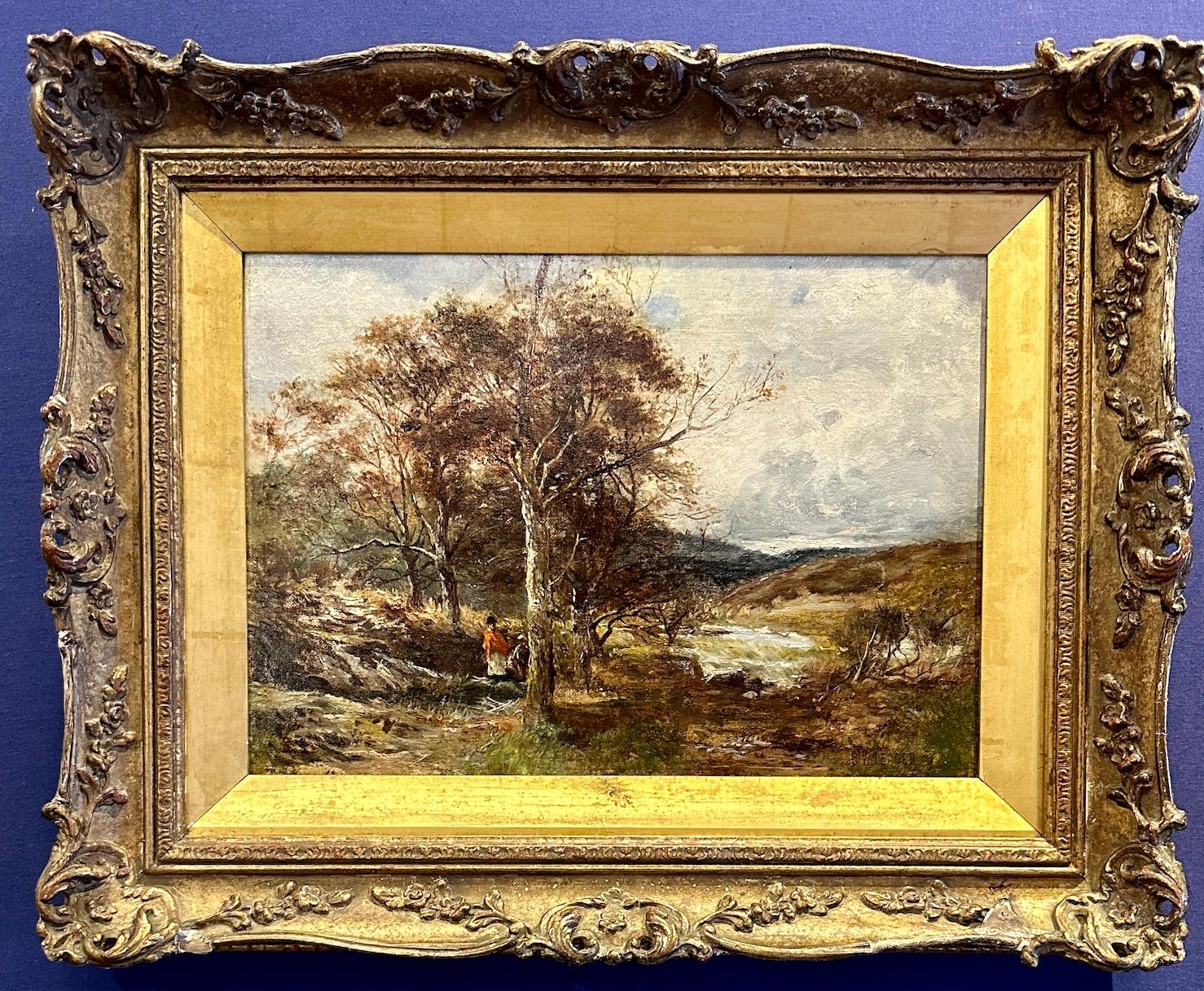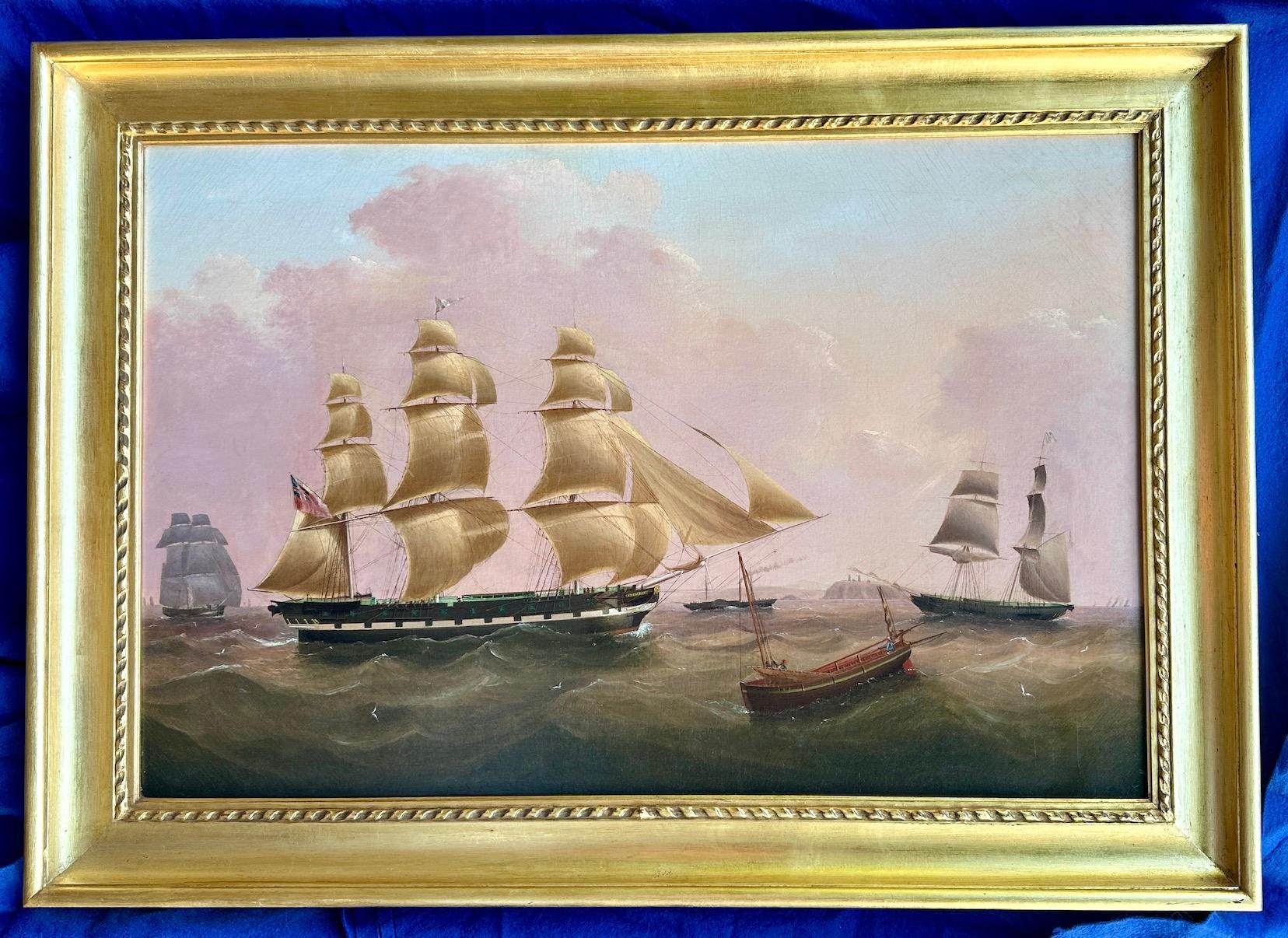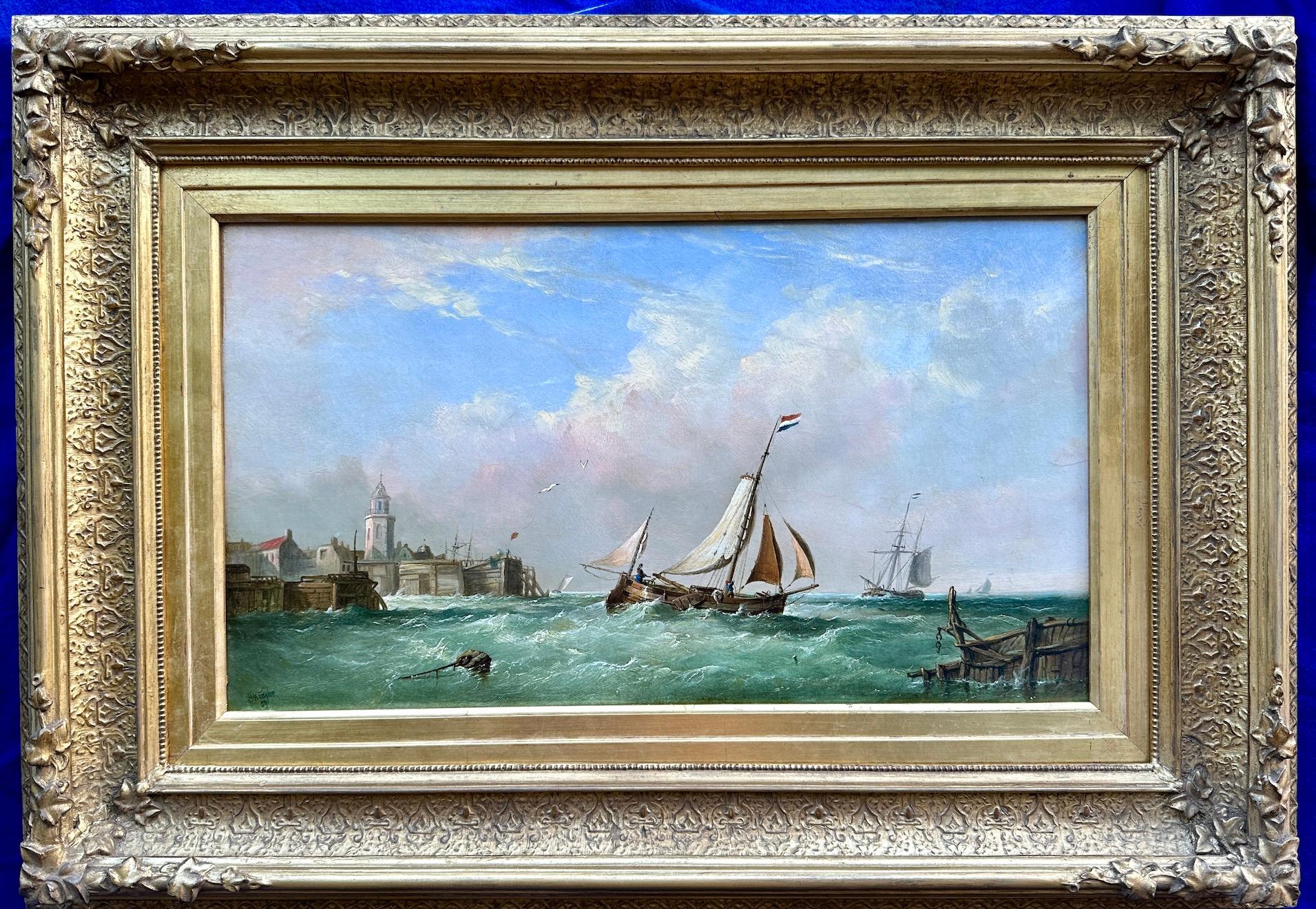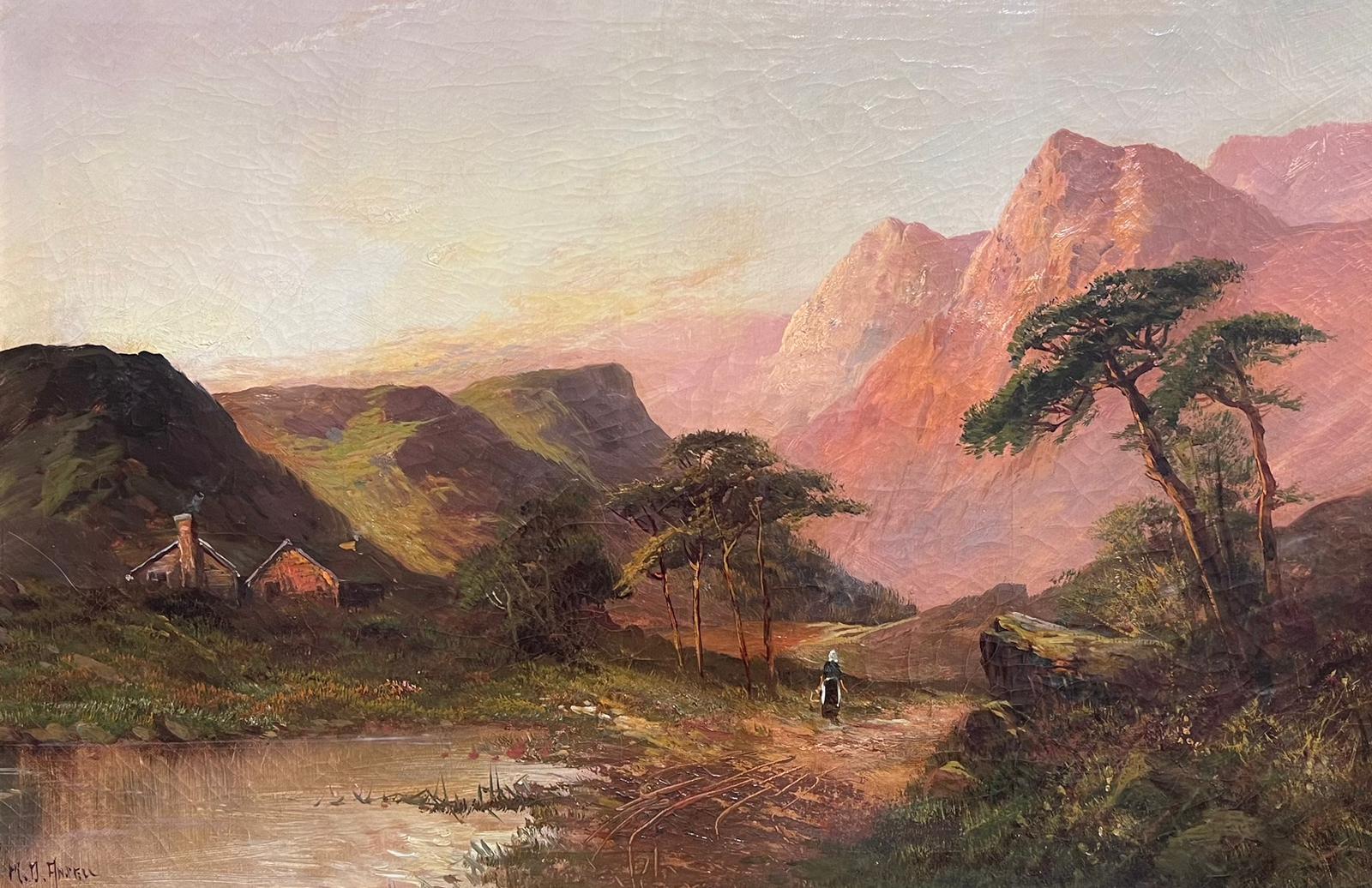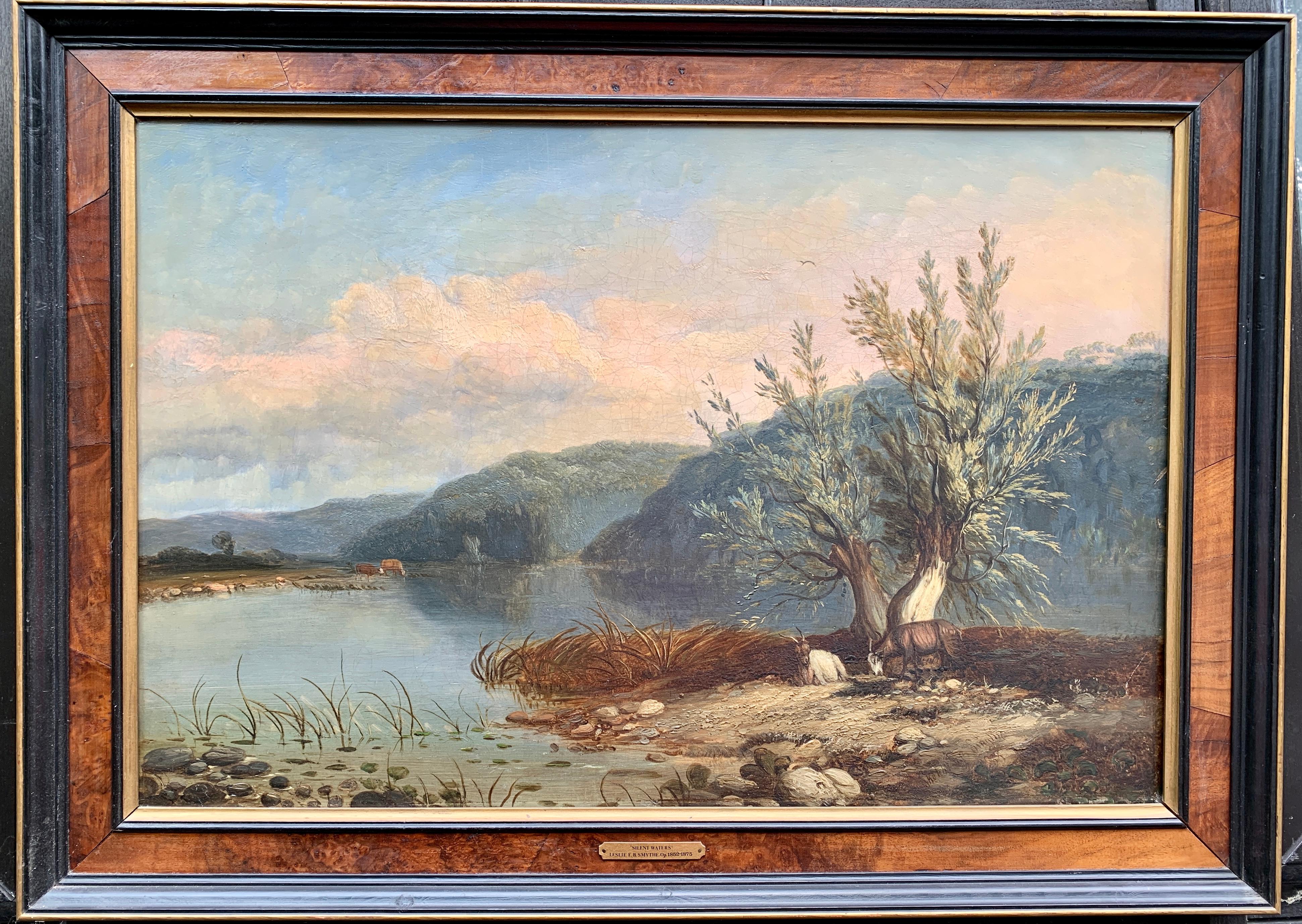Edward Williams19th Century landscape oil painting of figures in a lane near Abbey ruins C1830
C1830
About the Item
- Creator:Edward Williams (1782 - 1855, English)
- Creation Year:C1830
- Dimensions:Height: 28.25 in (71.76 cm)Width: 36.75 in (93.35 cm)Depth: 2.75 in (6.99 cm)
- Medium:
- Movement & Style:
- Period:
- Condition:
- Gallery Location:Nr Broadway, GB
- Reference Number:1stDibs: LU15629429852
Edward Williams
Edward Williams, born in London in 1781, was an English landscape painter during the Victorian era. He had six sons, who became well-known landscape painters as well. He came from a family of artists — his mother, Mary Ward, was the sister of the animal painter James Ward and the engraver William Ward, but also the sister-in-law of the figure-painter George Morland, and of the animal painter Henry Chalon; his father was an engraver who worked with John Raphael Smith. Edward Williams was sent around 1792 or 1793 to live with his maternal uncle James Ward, R.A. (1769–1859), but it seems unlikely that he received any painting instruction from him. Instead, he was informally apprenticed to a carver and gilder named Thomas Hillier, who had a shop on Carnaby Street and he became quite successful to enjoy a comfortable living. Williams between 1814–55 exhibited at the Royal Academy of Arts (36 works), British Institution (21 works), Suffolk Street Gallery of the Society of British Artists (38 works), and elsewhere. He started by painting miniatures and copying Baroque landscapes from the 1600s in the style of the Dutch painters Ruisdael (1628–82) and Hobbema (1638–1709), the former known for woodland scenes with detailed renderings of trees, particularly the leaves, and water scenes with small boats moored beneath windmills; the latter known for his densely foliated trees with stippled leaves. As Williams developed his style, in which the figures, if present at all, were generally subordinate to the scenery, he moved on to contemporary landscapes of the English countryside that, not surprisingly, a hint of some of the work of his uncle George Morland.
- ShippingRetrieving quote...Ships From: Nr Broadway, United Kingdom
- Return PolicyA return for this item may be initiated within 3 days of delivery.
- Early 19th Century landscape oil painting of a farmBy Hermanus van BrusselLocated in Nr Broadway, WorcestershireHermanus van Brussel Dutch, (1763-1815) The Farmyard Oil on canvas Image size: 18.25 inches x 21.25 inches Size including frame: 24.5 inches x 27.5 inches Provenance: Frost & Reed V...Category
Early 19th Century Victorian Landscape Paintings
MaterialsCanvas, Oil
- 19th Century Lancashire river landscape oil painting of Doeford BridgeBy Henry H. ParkerLocated in Nr Broadway, WorcestershireHenry H Parker British, (1858-1930) Doeford Bridge, Clitheroe Oil on canvas, signed & further inscribed in pencil to stretcher Image size: 11.5 inches x 17.5 inches Size including frame: 16.5 inches x 22.5 inches Provenance: MacConnal-Mason Ltd, Duke Street, London This attractive scene featuring Doeford Bridge near Clitheroe is by Henry H Parker. Two figures can be seen on the bridge overlooking the river Hodder. Doeford Bridge is located in Bowland Forest Low, Lancashire, 9 miles north-west of Clitheroe between Chipping Village and Whitewell. It spans over the river Hodder, near the confluence of the rivers Hodder and Loud. The bridge was built around 1770 and was constructed with squared sandstone blocks formed into 2 segmented arches with a central triangular cutwater. It was made a grade II listed building by Historic England in 1952. Henry Parker was born in the St Pancras area of London on 27 June, 1860 and was christened Henry Deacon...Category
19th Century Victorian Landscape Paintings
MaterialsCanvas, Oil
- 19th Century landscape oil painting of sheep in a Sussex laneBy William Luker Sr.Located in Nr Broadway, WorcestershireWilliam Luker Snr British, (1828-1905) Sheep in a Sussex Lane with Pevensey Bay in the distance Oil on canvas, signed & dated 1875 Image size: 17.25 inches x 25.25 inches Size including frame: 23.25 inches x 31.25 inches A tranquil landscape scene of a shepherd and his flock resting in a lane near Pevensey Bay, Sussex by William Luker. The ruins of Pevensey Castle can be seen in the distance with the sea beyond. William Luker Snr was born in 1828 at Faringdon, Berkshire to William and Jane Luker (née Charlwood). His father was a plumber and glazier by trade and the family lived at London Street in Faringdon. Little is known about his early education and it is believed for the most part he was self -taught. However, given the quality of his work and the fact that his family were able to keep a servant, he may well have received some artistic tuition. By the early 1850’s, he had begun earning a living as an artist by advertising in local directories, earning commissions from local landowners. He made his debut at the Royal Society of British Artists in 1851 and was a prolific exhibitor there for over 40 years. He began exhibiting at the Royal Academy in 1852 and also exhibited at the British Institution. He married the artist Ada Augusta Margetts (1839-1930) on 27 October 1864. Their eldest son William Luker Jnr (1867-1951) also became a well-known artist. The couple soon moved to London where they lived at 22 Gloucester Terrace, Campden Hill from where they both exhibited. From 1867, they lived at 15 Sheffield Terrace in Kensington until 1874 when they moved for the final time to 22 Notting Hill Square, later renamed Campden Hill Square in 1893. He died at Campden Hill-square on 28 February, 1905. Luker specialised in landscapes featuring animals such as sheep and cattle, horses and deer. He travelled around visiting areas such as Sussex, Buckinghamshire, Kent, Wales and the Highlands. However, he also made trips to Egypt and Libya producing a series of Oriental scenes in the early 1860’s. His works show a great attention to detail and his use of a lighter palette gives his subjects a luminous quality that instantly attracts the viewer. Examples of his paintings are held by the Atkinson Art Gallery, National Library of Wales, Newstead Abbey...Category
19th Century Victorian Animal Paintings
MaterialsCanvas, Oil
- 19th Century Highland landscape oil painting of sheep near Loch AweLocated in Nr Broadway, WorcestershireWilliam Watson Jnr British, (1847-1921) On the Mountains, Loch Awe Oil on canvas, signed & dated 1892, further inscribed verso Image size: 12.5 inches x 18.5 inches Size including frame: 18.5 inches x 24.5 inches A wonderful painting of Highland sheep resting near Loch Awe by William Watson Jnr. Loch Awe is located in Argyll and Bute in the Scottish Highlands and this scene is taken from the mountain side overlooking the loch. William Watson was born in Islington in 1847, the son of the London miniature painter William John Watson (1810-1871) and his wife Caroline (née Butcher). His brothers Charles Watson (1837-1900) and Robert Watson (1855-1921) were also artists. His father seems to have travelled around and after spending time in Brighton, the family moved to Bransford Road in Worcester during the early part of the 1860’s. As well as being taught by his father, Watson received his early training in the studio of Sir Francis Grant PRA (1803-1878). He later became a pupil of Sir Edwin Henry Landseer RA (1802-1873) and Rosa Bonheur (1822–1899). Both Landseer and Bonheur had a great influence on his work and he began specialising in scenes of cattle and sheep. By 1866 he had become a full time artist and began exhibiting at the Royal Society of British Artists. Perhaps to take advantage of the inspiring scenery, Watson moved to Birkenhead, Cheshire where in 1871 he met and married Eleanor Davies who was from Caernarvonshire. Four of their children Sidney Watson (1881-1931), Caroline Ellen...Category
19th Century Victorian Animal Paintings
MaterialsCanvas, Oil
- 19th Century river landscape oil painting of figures crossing stepping stonesBy Robert John HammondLocated in Nr Broadway, WorcestershireRobert John Hammond British, (1853-1911) Stepping Stones Oil on canvas, signed & dated 1900 Image size: 20.75 inches x 13.75 inches Size including frame: 30.5 inches x 23.5 inches A pretty painting of figures crossing stepping stones over a river by Robert John Hammond. Behind the figures a path leads towards two cottages at the foot of a mountainous landscape. The landscape is similar to that of North Wales, a location which Hammond returned to a number of times. Robert John Hammond was a landscape painter born in Blackfriars, London in 1853. By the time he was 18 he had moved to Sutton Coldfield where he initially became an apprentice watchmaker before becoming a full time artist. In 1871, he married Lucy Banner, the sister of the artist Alfred Banner...Category
19th Century Victorian Landscape Paintings
MaterialsOil, Canvas
- 19th Century pair of seascape oil paintings of fishing boats near RochesterBy Hubert ThornleyLocated in Nr Broadway, Worcestershire**PLEASE NOTE: EACH PAINTING INCLUDING THE FRAME MEASURES 16.25 INCHES X 22.25 INCHES** Hubert Thornley British, (exh. 1858 -1898) Rochester on the Medway & Moonset Nr Queenborough ...Category
19th Century Victorian Landscape Paintings
MaterialsCanvas, Oil
- 19th century Scottish Highland lock landscape with Highland Cattle drinkingLocated in Woodbury, CTLate 19th century Scottish Highland Lock landscape, with Cattle watering E.Mulready was almost certainly a pseudo name for William Langley a well known English painter of landscapes...Category
1890s Victorian Landscape Paintings
MaterialsOil, Canvas
- 19th century Fall English landscape with figures on a path in the highlandsBy Benjamin Williams LeaderLocated in Woodbury, CTWonderful Autumn/Fall landscape by one of Englands finest landscape painters. Born as Benjamin Williams, the artist added the surname Leader (his Father’s middle name) to distingui...Category
1880s Victorian Landscape Paintings
MaterialsCanvas, Oil
- English 19th century portrait of the Clipper ship Crescent at sea in full sailBy John LynnLocated in Woodbury, CTEnglish 19th century portrait of the Clipper ship Crescent in full sail. Acquiring a 19th-century English portrait of a clipper ship is more than just adding a painting to your coll...Category
1850s Victorian Portrait Paintings
MaterialsCanvas, Oil
- 19th century English marine Sailing scene of Dutch fishing boats by a harborBy Henry King TaylorLocated in Woodbury, CTHenry King Taylor was a marine and coastal scene painter who lived in London. He exhibited at the Royal Academy from 1859 to 1864 with titles includi...Category
1850s Victorian Landscape Paintings
MaterialsCanvas, Oil
- Antique Scottish Highland Landscape Oil Painting Figures Walking Sunset GlenLocated in Cirencester, GloucestershireThe Highland Glen by F. E. Jamieson (British 1895-1950) signed with pseudonym oil painting on canvas, framed framed: 25.5 x 35 inches canvas : 20 x 30 inches provenance: private coll...Category
Early 20th Century Victorian Landscape Paintings
MaterialsCanvas, Oil
- 19th century English rural landscapes, with goats by a river and peopleLocated in Woodbury, CTLESLIE E.B. SMYTHE 19th century English rural landscapes, with goats by a river and people. Smythe was an English painter who was active paintings in both Scotland and England. He ...Category
1860s Victorian Landscape Paintings
MaterialsCanvas, Oil

